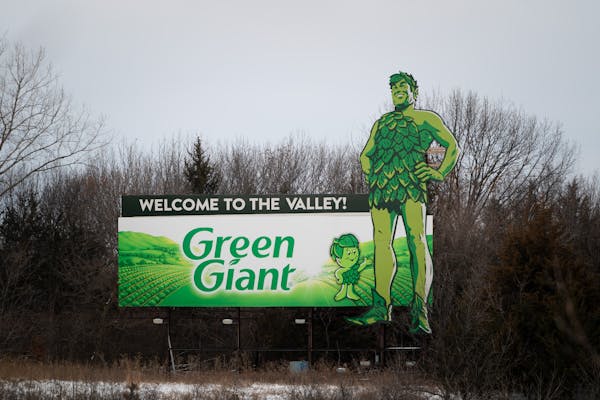Why did so many Jewish people move to St. Louis Park decades ago?
Listen and subscribe to our podcast: Via Apple Podcasts | Spotify | Stitcher
Minnesota's Jewish population is famously associated with the city of St. Louis Park.
The western suburb was the hub of Jewish life in the Twin Cities for the latter half of the 20th century. And it produced several Jewish celebrities who cast a national spotlight on their hometown, including the Coen brothers, Al Franken and Thomas Friedman.
But why did so many Jewish people move to St. Louis Park decades ago? Andover resident Sharon Carlson posed that question to Curious Minnesota, the Star Tribune's reader-powered reporting project (of which Carlson is a superfan).
It is a question the folks at the St. Louis Park Historical Society get often.
"It is fairly remarkable that we have about 20 times the synagogues per capita as any other community in Minnesota," said Bill Beyer, who edits the Historical Society's quarterly newsletter.
One explanation is that St. Louis Park, unlike other cities, welcomed Jews seeking a new life in suburbia after World War II. Jews leaving their roots in Minneapolis at the time were part of a middle-class Jewish migration to the suburbs that was happening around the country.
Once a sparsely populated industrial area, St. Louis Park was an attractive place to settle because many of its new post-war starter homes were free of the restrictive covenants and discrimination that barred Jews in other areas, said Twin Cities historian Laura Weber.
"It was where houses were being built that they could buy," she said. "And then again, people did want to move with their relatives and their friends. It had a momentum of its own."
One of the new suburb's early developers was Adolph "Bob" Fine, who built at least 2,000 homes and sold to Jewish buyers at a time when others did not, according to the St. Louis Park Historical Society.
By 1967, St. Louis Park's city manager estimated the "population included about 30 percent Catholics, 25 percent Jews and the remainder Protestants," according to a St. Louis Park Dispatch article cited by the Historical Society.
Leaving Minneapolis
The community's shift from city to suburb — which happened largely within two decades — meant leaving behind deeply rooted Jewish enclaves in Minneapolis.
Minneapolis' Jewish population shot up around the turn of the 20th century, and primarily settled in two areas. A small neighborhood took shape near Elliot Park and a larger one developed on the North Side — where 11 Orthodox synagogues were founded between 1884 and 1905.
But that started to shift after the war. In 1949, 60% of the greater Minneapolis area's 23,000 Jews lived on the city's North Side. By 1959, that number had fallen dramatically and 28% were living in St. Louis Park, Weber wrote in an article for the Minnesota Historical Society's MNopedia site.
The 1960s saw further migration, as more Minneapolis synagogues and Hebrew schools made the move.
"When you have these institutions moving out of the neighborhoods, the neighborhoods lose their center of gravity," Weber said. "The center of gravity changes to a new place."
In 1961, when Minneapolis' Near North synagogue Beth El bought land in St. Louis Park in preparation to move there, a Minneapolis Star reporter interviewed families and community leaders who were part of what he called the "exodus" from Minneapolis to the suburb.
Beth El's rabbi said he was following his members — since about 1,000 of his 2,500-member congregation had already settled in St. Louis Park.
Seymour Frank, who grew up in North Minneapolis, told the paper that he and his wife couldn't find vacant land to build a home in his old neighborhood. "But there were some lots in St. Louis Park, so that's where we went," he said.
B'nai Abraham synagogue's rabbi told the Star it was all about religious schools — that if a family bought a house in Richfield instead of St. Louis Park, for example, their kids couldn't ride the bus to Torah classes.
Norman Dockman, executive director of the Minneapolis Federation for Jewish Service, told the paper that houses in north Minneapolis were old and deteriorating. He added that low-income Black families moving in "intensified the Jewish movement out."
The strained relationship between Black and Jewish residents in north Minneapolis only worsened in the following years. In July 1967, Black residents protested along Plymouth Avenue, decrying mistreatment and discrimination from police and, by some accounts, Jewish business owners, according to a Minnesota Historical Society article about the event.
In three nights of civil unrest, part of a nationwide outpouring of anger about racial injustice that year, two Jewish-owned businesses burned to the ground. Many Jewish residents who had resisted the suburbs' pull decided it was now time to go.
An evolving city
The Twin Cities Jewish community has since become more dispersed. Many of the Jewish delis (including one-time favorite Lincoln Del) and businesses that once were concentrated in St. Louis Park have closed.
Even so, matzah ball soup is on the menu at Yum Bakery. And a new kosher restaurant called Shiloh is set to open on Minnetonka Boulevard in a strip mall that's also home to grocery store Kosher Spot.
The strip mall is within the 1-mile-square eruv, first set up with wires in 1990, that defines a boundary around the neighborhood's Orthodox Jewish community and allows them to do some activities that Jewish law normally prohibits on the Sabbath.
Today, the Twin Cities' largest share of Jewish households (31%) lives in suburbs close to Minneapolis, such as Minnetonka, Bloomington, Plymouth, Maple Grove and St. Louis Park, according to a 2019 Brandeis University study.
St. Louis Park's tight-knit Jewish community of the mid-20th century included several children who went on to great prominence on the national scene.
Former Vice President Walter Mondale described them in a 1999 op-ed as a "remarkable cast of Minnesota talent who grew up in St. Louis Park about the same time." The list includes directors Joel and Ethan Coen, New York Times columnist Thomas Friedman, comedian-turned-politician Al Franken, and political commentator Norm Ornstein.
Franken, in the op-ed, joked they were all part of the "Jewish Mafia" — not gangsters but "the elite cadre of great thinkers and artists who went to Hebrew school in St. Louis Park in the 1960s."
The Coen brothers would later create a film about Jewish life in St. Louis Park in the 1960s, "A Serious Man," based partly on their own childhood.
"I think it was a typical suburban upbringing except for the fact that there was a large Jewish minority in this particular suburb and it was a pretty active community," Joel Coen told Charlie Rose in 2009 while promoting the film. "And that was a large part of our upbringing there, as it was [for] most of the other Jewish kids in that suburb."
If you'd like to submit a Curious Minnesota question, fill out the form below:
Read more Curious Minnesota stories:
Where did streetcars once travel in the Twin Cities suburbs?
Why do tiny cities like Lauderdale, Landfall, Lilydale, & Falcon Heights exist?
West, North, South, Park: Why are there so many suburbs named St. Paul?
Why do we have water towers and what do they do?
Why do Minnesotans have accents?
Why was the career of Minnesota's first congresswoman cut short?
Correction: This article has been updated to clarify where the largest share of Twin Cities' Jewish households currently live. This article has been updated to add attribution about the 1967 unrest in north Minneapolis.








